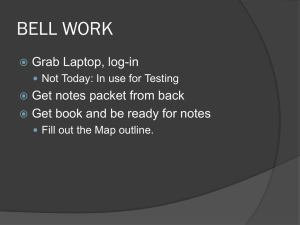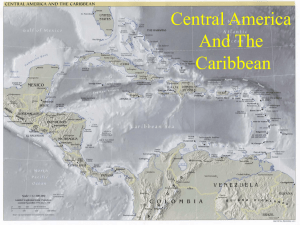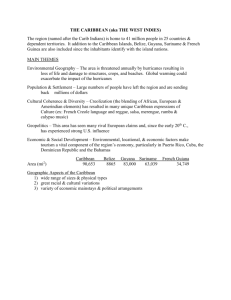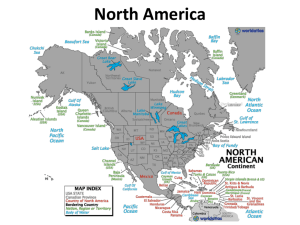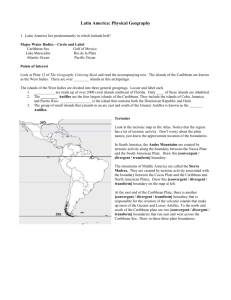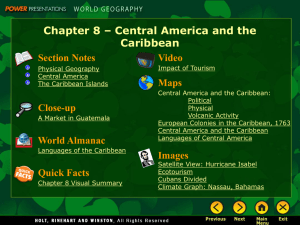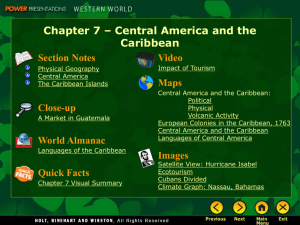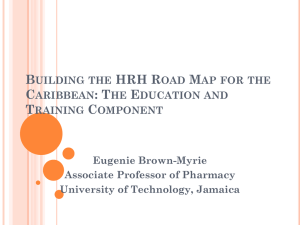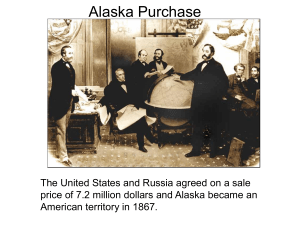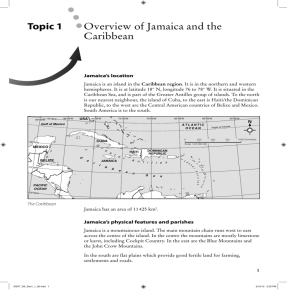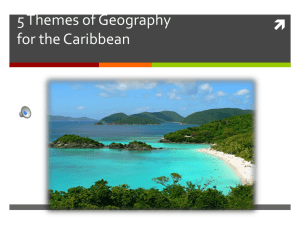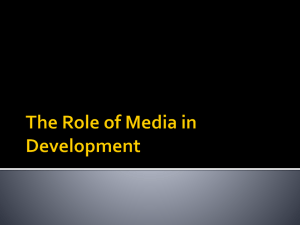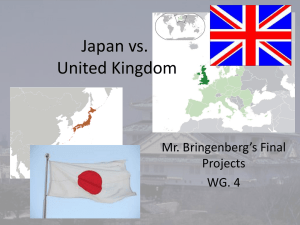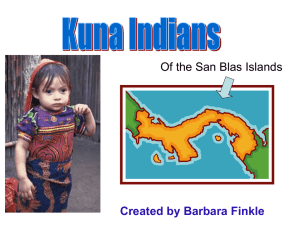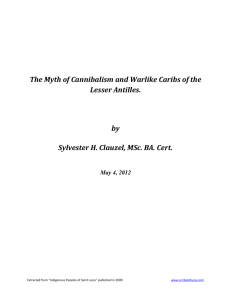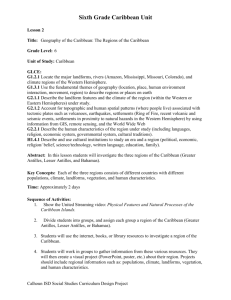Chapter 11
advertisement
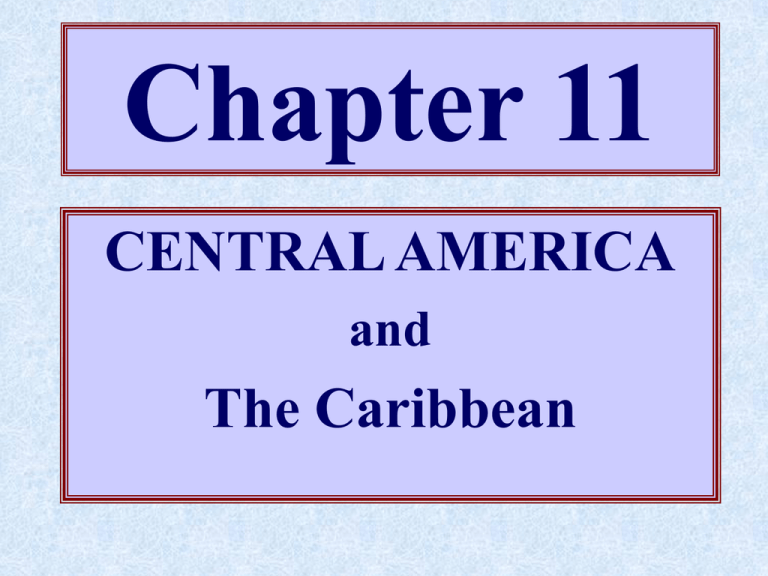
Chapter 11 CENTRAL AMERICA and The Caribbean A. Central America 1. 2. 3. 4. 5. 6. 7. Guatemala Belize Honduras El Salvador Nicaragua Costa Rica Panama B. Isthmus 1. Narrow strip of land with water on both sides. 2. Central America is a land bridge between North & South America C. Landforms & Climates 1. Mountainous Core 2. Runs the length of Central America 3. Some are over 13,000’ above sea level C. Landforms & Climates 4. Between 3,000’ and 6,000’ the climate is spring-like all year. a. Corn, Coffee & wheat are grown 5. Above 6,000’, it is too cold for many crops a. Potatoes and barley are grown 6. Caribbean Lowlands a. On the eastern side b. Edge of the Caribbean Hot Humid Heavy rainfall c. Soil is NOT fertile, limiting crops Landforms & Climates Caribbean Lowlands Nicaragua Landforms & Climates Pacific Coastal Plain 7. Pacific Coastal Plain a. Tropical wet/dry climate Rain in the summer Dry in the winter b. Local volcanoes have produced fertile soils D. The People 1. Several ethnic groups a. Isolated due to mountains b. Mountains make it hard for people to “mix” 2. INDIANS a. Largest number live in Guatemala 3. EUROPEANS a. Spain conquered and colonized in the 1500s b. MESTIZOS: Found throughout Central America 4. AFRICANS a. SOME are descendents of slaves b. Most are descendents of Africans who immigrated to the region in the early 1900s. c. Many came to build the Panama Canal E. WEALTH & POVERTY 1. Most people are very poor 2. At least 2/3 of the population 3. The wealthy are mostly Europeans or Mestizo 4. The wealthy dominate the government 5. There is a small, but growing middle class F. FARMING ECONOMY 1. Most farming is subsistence farming 2. In Guatemala and Honduras, 50% of the population are in farming 3. Some people work on huge plantations for very low wages F. FARMING ECONOMY 4. Greatest export crops in Central America: a. Cotton, Bananas & Coffee 5. Hurricane Mitch in 1998: a. Destroyed much G. Political Unrest 1. Continuing struggle between the rich landowners and the poor. 2. Death Squads: Killers hired by wealthy to kill any one who disagrees with the government. a. Many people in El Salvador and Guatemala were killed. 3. Some ended in revolutions and counter-revolutions. H. GUATEMALA 1. Largest population in Central America 2. Agricultural Economy a. Coffee, Sugar & Bananas 3. Descendents of the Mayans 4. Mayans are the majority 5. But, Ladinos Rule a. Ladinos: Mestizos who follow European Ways I. BELIZE 1. English colony (main language is English) 2. Present population: a. b. c. d. 50% Mestizo African European Asian J. PANAMA CANAL 1. In 1881, France contracted with Colombia to build a canal 2. Problems: a. Mud slides b. Mountains c. Malaria 3. After a few years, the digging stopped. 4. 40 years later, the U.S. built the canal. K. WHY BUILD A CANAL? 1. New York To San Francisco (S. Am.) 13,000 miles 2. New York To San Francisco (Canal) 5,200 miles L. CARIBBEAN ISLANDS 1. The three island groups: a. Greater Antilles South of Florida Jamaica Hispaniola Puerto Rico Cuba b. Lesser Antilles (Southeast of Florida) c. Bahamas (East of Florida) 2. Archipelago (ar kih PEHL ih goh) a. A group of islands M. Island Formation 1. Greater Antilles & some Lesser Antilles are the tops of volcanoes. a. Some are still erupting b. Volcanic ash creates very good soil 2. Others, usually the smaller ones, are coral islands. a. All of the Bahamas are Coral islands. N. MARINE CLIMATE 1. Winds blow over the cooler, ocean waters, and “air-conditions” the islands a. Average year-round high is 800 2. Windward side receives rainfall 3. Leeward side is dry O. ETHNIC ROOTS 1. 2. 3. Earliest peoples were the Cibonay & Caribs (Caribbean) After the Europeans had conquered Latin America, many natives died from the diseases that the Europeans brought. Others died from enslavement and cruel treatment. P. AFRICAN DESCENT 1. Millions of Africans were brought as slaves to work the sugarcane plantations. 2. Some emigrated to find work 3. Invented calypso music a. Steel drums b. Satirical Lyrics Q. ASIANS 1. Descendents of Asians who came to the Caribbean in the 1800s to work. 2. After slavery was abolished, plantation owners sought for cheap labor R. The Caribbean Today 1. Most Caribbean peoples live in independent countries 2. Some islands are still linked to U.S. and Europe a. British Virgin Islands b. U.S. Virgin Islands c. Martinique (France) S. Commercial/Subsistence 1. Huge plantations producing: a. Bananas, Rice and Cotton b. Locals are hired at low wages to work the plantations and vacation resorts. 2. Many other people grow food for their own family. T. MIGRATION 1. Movement of people 2. Usually for employment a. Sometimes Temporary b. Sometimes Permanent 3. Hundreds of thousands came to build the Panama Canal U. POLITICAL UNREST 1. Communism in Cuba a. Fidel Castro took power in 1959; we’re still waiting for him to go. 2. Military dictatorships in Haiti a. Papa Doc & Baby Doc were two of the worst 3. Many Cubans and Haitians immigrated to the U.S. a. Send $$$$ home to help the family Reach For A Star Production John P. Luke www.mrluke.net

